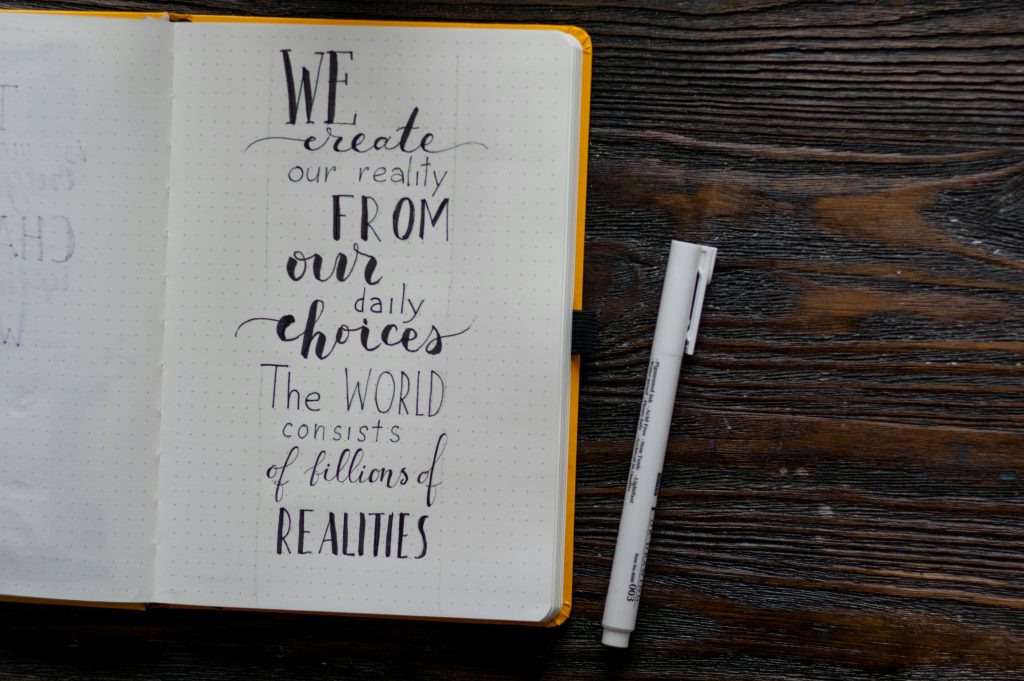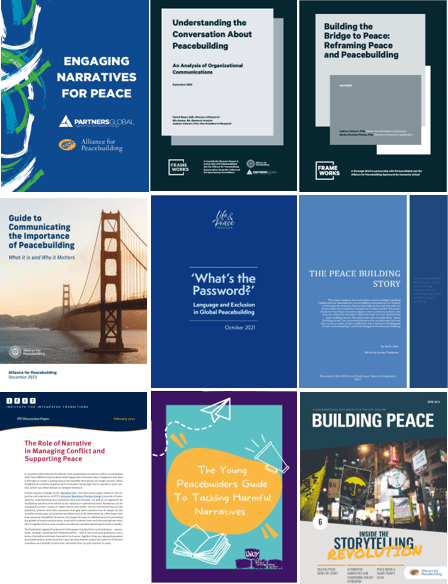Use these resources to help you develop creative and effective peacebuilding narratives for education, advocacy, and action.
by Jocelyn Wright | 19 July 2024
Photo by Elena Mozhvilo on Unsplash
“In the end, the story of peace must be a shared tale of triumph over tragedy.” – Tara Sonenshine, “Selling Peace: Story by Story” in Building Peace
In 2018, I “discovered” a new branch of linguistics through the inspiring work of Brazilian scholar Francisco Gomes de Matos: peace linguistics. I have gone on to define peace linguistics as “an interdisciplinary field guided by the goal of promoting peace and peacebuilding through systematic study, deliberate teaching, and conscious use of languages spoken, written, and signed” (Wright, 2021). This field opened my eyes to peacebuilding language, discourse, and communication, hence my interest in peacebuilding narratives.
There is a need for peacebuilding at different levels and diverse creative approaches to achieving progress on various issues which present obstacles to peace. In the face of numerous struggles for sustainable safety, health, dignity, justice, equity, and harmony, peace and peacebuilding narratives seem ever more necessary to reduce violence and offer constructive alternatives to raise awareness of, build support for, and gain funding and assistance for conflict prevention and transformative research, policy, education, and action towards a regenerative world. However, some peacebuilding narratives may be more effective than others.
This topic has recently been studied and discussed in papers, reports, briefs, and guides. In an effort to share insightful resources, this brief post summarizes nine. Near the end, it categorizes practical recommendations for studying, developing, and sharing peacebuilding narratives, the main takeaways from this review.
Resources on peace and peacebuilding narratives
Below are nine resources to help you develop creative and effective peacebuilding narratives. They are drawn from diverse sources, each offering valuable perspectives and insights.
Engaging Narratives for Peace (2019) | by Julia Roig, PartnersGlobal & Alliance for Peacebuilding.
This 20-page exploratory report addressed to peacebuilders focuses on collective reflection on current peacebuilding narratives from the individual or organizational to the societal. After drawing on academic work to present key elements of narratives (as distinguished from stories) and ways they work to promote social change, it discusses social media campaigns and how to engage with narratives, to create meta-narratives that will appeal to non-peacebuilders. At the end, it lists five recommendations.
Understanding the Conversation About Peacebuilding: An Analysis of Organizational Communications (2020) | by Daniel Busso, Mia Aassar, and Andrew Volmert, FrameWorks Institute
By identifying framing strategies in existing narratives, this 16-page report by a non-profit think-tank attempts to highlight often neglected questions in organizational communications that, if answered, could help the American public understand the importance of peace and peacebuilding and what a peacebuilding approach entails. It centers on three concrete recommendations.
Building the Bridge to Peace: Reframing Peace and Peacebuilding (April 2022) | by Andrew Volmert and Marisa Gerstein Pineau, FrameWorks Institute.
This 20-page strategic brief by the same institute focuses on reframing the way Americans across political divides think, feel, and talk about peacebuilding, challenging unhelpful or ineffective dominant assumptions and ideas (e.g. that peace is abstract, locally irrelevant, or costly, that it is achievable through passive, simplistic, or temporary efforts or military strength, or, fatalistically, that violence is simply inevitable) by providing an evidence-based narrative or framework centered on supporting interconnections to increase understanding, change/reorient discourse, and shift mindsets to drive positive and durable social change. It offers five well-motivated recommendations.
Guide to Communicating the Importance of Peacebuilding What it is and Why it Matters (2023) | by Nick Zuroski, Alliance for Peacebuilding.
The result of evidence-based approaches, this 10-page guide argues the importance of strategically “reforming peacebuilding narratives” (p. 1) by clearly and effectively explaining what peacebuilding and conflict prevention are and why they are important, or why they “must be centered, integrated, and robustly resourced in strategies, policies, and laws” (pp. 1/3), for better advocacy and communication. It focuses on examples from the Global Fragility Act (GFA) and Women, Peace, and Security (WPS) Act that illustrate five recommendations.
‘What’s the Password?’ Language and Exclusion in Global Peacebuilding (October 2021) | by Luke Errington-Barnes, Life & Peace Institute
This 35-page reflective report, or “learning paper” (Acknowledgements), focuses on the goal of “more inclusive (or at least less exclusive)” (p. 3) approaches to communication that connect peacebuilders from the global to the local. Specifically, adopting a critical discourse analysis perspective, it undertakes a case study of discourse practices and language used at the 2019 High-Level Political Forum event in New York. The report shows that these tend to get in the way due to the power structure and relations and dominant discourse. As a result, language is “inaccessible, needlessly complex, and often untranslatable” (p. 4). Rather than offering recommendations, the report raises questions for reflection for more sustainable discourse, which may be relevant for peacebuilding narratives.
The Peace Building Story (2012) | by Eneko Sanz, presented at the CPCS Peace Practitioners’ Research Conference 2012.
A little older but still relevant, this 33-page conference paper looks at narrative framing of (international post-conflict) peacebuilding policy in general and intervention strategic planning frameworks, examining characters (heroes and allies, victims, partners, and donors) and plots structured around security, development, and political reform. Advocating for emancipatory peacebuilding, the paper concludes “a narrative policy analysis can help us read and construct different discourses on peacebuilding” (p. 2), ones that may be silenced or obstructed by “master narratives”.
The Role of Narrative in Managing Conflict and Supporting Peace (2021) | by Sara Cobb, Seth Kaplan, Alexandre Marc, and Gary Milante, Institute for Integrated Transitions (IFIT).
Using a tree analogy, this 18-page discussion paper presents a cyclical framework, involving assessment, strategic planning, and implementation, for iteratively analyzing and enriching narratives over the long run with the aim of contributing positively to the “narrative landscape” (p. 1), a “complex ecosystem” (p. 8), and, thereby, facilitating the reduction or constructive management of conflict. Besides concrete steps and activities for each phase of the framework at different levels, the paper offers a useful list of 16 tools for narrative work.
The Young Peacebuilders’ Guide to Tackling Harmful Narratives (2022) | by United Network of Young Peacebuilders (UNOY)and Swedish International Development Cooperation Agency (SIDA)
The result of a capacity-developing program, this 47-page “by-youth-for-youth guide” (p. 4), a collaborative compilation of practical tools, resources, and methodologies, is designed to serve as a resource for young peacebuilders and youth-led organizations who wish to counter disinformation, fake news, and hate speech and create alternative narratives, especially through campaigns. It begins with a helpful glossary.
Building Peace: Inside the Storytelling Revolution (April 2016) | by Jessica Berns (Editor), Alliance for Peacebuilding.
For those who find reports and guides tedious, the last resource here, a special issue of the magazine Building Peace, consisting of five exemplary articles, may be of interest. Spread across 24 engaging pages, stories of peacebuilding told from various perspectives (advertising, activism, policymaking, and filmmaking) demonstrate the power of narratives, innovative storytelling, and creative media use in the developing “storytelling ecosystem” (El-Gamal, p. 17). Recommendations are woven into the lines.
Practical recommendations from the above resources
Developing creative and effective peacebuilding narratives requires knowledge, skill, and persistent effort. However, they may contribute to progress on myriad social issues and serve to advance peacebuilding efforts.
Pulled out from the above resources are thirty recommendations for peacebuilding narratives which have been categorized for ease. Some may apply better to certain situations and contexts than others. Customized variations of this compilation could serve as checklists.
Analyzing and researching peacebuilding narratives
- Explore the narrative landscape.
- Listen to new or alternatives narratives.
- Critically examine all narratives for biases.
- Explore the effectiveness of peacebuilding frames.
Building narratives
- Clearly identify the narrative conflict.
- Establish facts and roots of the conflict.
- Consider audience, perspective/positioning, and level of influence.
- Construct narratives through dialogue with diverse participants.
- Integrate different voices.
- Emphasize values like interconnectedness and interdependence.
- Name those (actors, groups, institutions) involved in peacebuilding.
- Explain steps involved.
- Focus on solutions rather than crises.
- Demonstrate that peacebuilding is possible but requires ongoing efforts.
- Honor the complexity of narratives.
Communicating narratives
- Aim for clear and accessible communication about peacebuilding.
- Adopt inclusive language.
- Make stories relatable.
- Illustrate with helpful metaphors like bridge building.
- Consider event sequencing for engagement.
- Select concrete examples to demonstrate peacebuilding.
- Use creative, multimodal means to share stories.
Advocating for peacebuilding
- Promote peacebuilding (as opposed simply to anti-military/war) narratives.
- Consistently explain rationales and goals of peacebuilding.
- Attempt to shift (rather than counter) narratives.
- Emphasize the cost-effectiveness of peacebuilding.
Disseminating peacebuilding narratives
- Build many and diverse partnerships and coalitions to disseminate narratives widely and effectively.
- Engage at different levels from micro to macro.
- Use appropriate platforms and media to communicate stories.
- Consider timing.
Invitation to engage with peacebuilding narratives
The power of narratives is undeniable, and, as stated in the introduction, creative and effective peacebuilding narratives, although a topic of relatively recent interest, seem critically indispensable. In this post, I have presented nine resources related to peace and peacebuilding narratives and thirty recommendations. Hopefully, you find them useful and inspirational and are stimulated to study, develop, and share more peacebuilding narratives with other (potential) peacebuilders around the globe.
Other References
Wright, J. (2021, July 6). ELT Concept #12 – Communicative peace and (applied) peace linguistics. Willy’s ELT Corner.
If you found this article helpful and want to find more blog posts like this mapping resources and organizations that build peace across a wide array of themes be sure to check out our Resources page!
Are there any peace and peacebuilding narrative resources that are missing in this blog post? If so, CLICK HERE to submit a resource that I can add to this blog post.
And be sure to sign up for our newsletter (the best peacebuilding newsletter out there!) to get connected with all the best articles, videos, podcast episodes, events, downloads, learning opportunities, and other resources on building peace published each week, selected from a broad array of global efforts to build peace. Subscribe by clicking HERE.
About the author
Jocelyn Wright, a Guest Writer for Everyday Peacebuilding, is Associate Professor at Mokpo National University in South Korea. Her interests lie in the interconnected areas of peace linguistics, peace (language) education, and peace literature. She currently facilitates the international Peace Linguistics group and the Korea TESOL Social Justice Special Interest Group. jocelynmnu@yahoo.com





